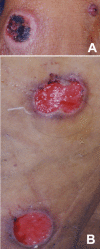Polymorphism-specific PCR enhances the diagnostic performance of American tegumentary leishmaniasis and allows the rapid identification of Leishmania species from Argentina
- PMID: 22894734
- PMCID: PMC3449195
- DOI: 10.1186/1471-2334-12-191
Polymorphism-specific PCR enhances the diagnostic performance of American tegumentary leishmaniasis and allows the rapid identification of Leishmania species from Argentina
Abstract
Background: The diagnosis of the leishmaniases poses enormous challenges in Argentina. The Polymorphism-Specific PCR (PS-PCR) designed and validated in our laboratories has been proven effective for typifying the Leishmania genus from cultured material. Here we evaluated the performance of this method in the diagnosis of American tegumentary leishmaniasis (ATL) and the rapid identification of Leishmania spp. directly from clinical specimens.
Methods: A total of 63 patients from northwestern Argentina, with cutaneous or mucocutaneous lesions, underwent an ATL diagnosis protocol which included clinical examination, Leishmanin skin test, and microscopic examination of dermal smears. In addition, we performed PS-PCR on DNA directly extracted from the specimens scraped from the lesions.
Results: Out of the 63 patients, 44 were classified as ATL cases and 19 as non-ATL cases. The diagnostic sensitivity of the microscopic analysis of dermal smears and PS-PCR individually were 70.5% and 81%, respectively. When performing both tests in parallel, this parameter increased significantly to 97.6% (p = 0.0018). The specificities, on the other hand, were 100%, 84.2%, and 83.3% for the combination, respectively (p > 0.05). Using the PS-PCR analysis we successfully identified the Leishmania spp. in 31 out of the 44 ATL cases. Twenty-eight (90.3%) cases were caused by L. (V.) braziliensis, two (6.5%) by L. (V.) guyanensis, and one (3.2%) by L. (V.) panamensis.
Conclusions: The efficacy of the ATL diagnosis was significantly improved by combining the dermal smear examination with a PS-PCR analysis. Our strategy allowed us to reach the diagnosis of ATL with high accuracy regarding the species of the etiological agent in 70.5% of the cases. Moreover, we diagnosed two cases of the disseminated cutaneous form caused by L. (V.) braziliensis and a cutaneous case due to L. (V.) panamensis infection, both findings reported for the first time in Argentina.
Figures


Similar articles
-
A FRET-based real-time PCR assay to identify the main causal agents of New World tegumentary leishmaniasis.PLoS Negl Trop Dis. 2013;7(1):e1956. doi: 10.1371/journal.pntd.0001956. Epub 2013 Jan 3. PLoS Negl Trop Dis. 2013. PMID: 23301111 Free PMC article.
-
High performance of an enzyme linked immunosorbent assay for American tegumentary leishmaniasis diagnosis with Leishmania (Viannia) braziliensis amastigotes membrane crude antigens.PLoS One. 2020 May 7;15(5):e0232829. doi: 10.1371/journal.pone.0232829. eCollection 2020. PLoS One. 2020. PMID: 32379842 Free PMC article.
-
The isolation and molecular characterization of Leishmania spp. from patients with American tegumentary leishmaniasis in northwest Argentina.Acta Trop. 2014 Mar;131:16-21. doi: 10.1016/j.actatropica.2013.11.015. Epub 2013 Nov 27. Acta Trop. 2014. PMID: 24291551
-
Accuracy of diagnostic tests for American tegumentary leishmaniasis: a systematic literature review with meta-analyses.Trop Med Int Health. 2020 Oct;25(10):1168-1181. doi: 10.1111/tmi.13465. Epub 2020 Aug 10. Trop Med Int Health. 2020. PMID: 32677284
-
Test accuracy of polymerase chain reaction methods against conventional diagnostic techniques for Cutaneous Leishmaniasis (CL) in patients with clinical or epidemiological suspicion of CL: Systematic review and meta-analysis.PLoS Negl Trop Dis. 2020 Jan 21;14(1):e0007981. doi: 10.1371/journal.pntd.0007981. eCollection 2020 Jan. PLoS Negl Trop Dis. 2020. PMID: 31961871 Free PMC article.
Cited by
-
Molecular Identification of Leishmania spp. DNA from Archived Giemsa-Stained Slides of Patients from Salta, Argentina.Am J Trop Med Hyg. 2018 Nov;99(5):1156-1161. doi: 10.4269/ajtmh.18-0223. Am J Trop Med Hyg. 2018. PMID: 30255828 Free PMC article.
-
Visceral Leishmaniasis Caused by Leishmania infantum in Salta, Argentina: Possible Reservoirs and Vectors.Am J Trop Med Hyg. 2015 Aug;93(2):334-9. doi: 10.4269/ajtmh.14-0267. Epub 2015 Jun 8. Am J Trop Med Hyg. 2015. PMID: 26055744 Free PMC article.
-
Applicability of kDNA-PCR for routine diagnosis of American tegumentary leishmaniasis in a tertiary reference hospital.Rev Inst Med Trop Sao Paulo. 2013 Nov-Dec;55(6):393-9. doi: 10.1590/S0036-46652013000600004. Rev Inst Med Trop Sao Paulo. 2013. PMID: 24213191 Free PMC article.
-
Pediatric cutaneous leishmaniasis in an endemic region in India.Am J Trop Med Hyg. 2014 Nov;91(5):901-4. doi: 10.4269/ajtmh.13-0737. Epub 2014 Oct 6. Am J Trop Med Hyg. 2014. PMID: 25294618 Free PMC article.
-
Diagnostic performance of a Recombinant Polymerase Amplification Test-Lateral Flow (RPA-LF) for cutaneous leishmaniasis in an endemic setting of Colombia.PLoS Negl Trop Dis. 2021 Apr 28;15(4):e0009291. doi: 10.1371/journal.pntd.0009291. eCollection 2021 Apr. PLoS Negl Trop Dis. 2021. PMID: 33909619 Free PMC article.
References
-
- Report of the Scientific Workving Group meeting on Leishmaniasis. World Health Organization, Geneva; 2004. pp. 5–16.
-
- Sosa Estani S, Campanini A, Sinagra A, Luna C, Peralta M, Coutada V, Medina L, Riarte A, Salomon D, Gomez A. et al.Clinical features and diagnosis of mucocutaneous leishmaniasis in patients of an endemic area in Salta. Medicina (B Aires) 1998;58(6):685–691. - PubMed
-
- Frank FM, Fernandez MM, Taranto NJ, Cajal SP, Margni RA, Castro E, Thomaz-Soccol V, Malchiodi EL. Characterization of human infection by Leishmania spp. in the Northwest of Argentina: immune response, double infection with Trypanosoma cruzi and species of Leishmania involved. Parasitology. 2003;126(Pt 1):31–39. - PubMed
-
- Marco JD, Barroso PA, Calvopina M, Kumazawa H, Furuya M, Korenaga M, Cajal SP, Mora MC, Rea MM, Borda CE. et al.Species assignation of Leishmania from human and canine American tegumentary leishmaniasis cases by multilocus enzyme electrophoresis in North Argentina. Am J Trop Med Hyg. 2005;72(5):606–611. - PubMed
Publication types
MeSH terms
LinkOut - more resources
Full Text Sources
Miscellaneous

